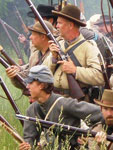The bicentennial of Abraham Lincoln's birth was celebrated in 2009. This year, 2011, marks a related sesquicentennial. Sesqui? What's that? It means "one and a half," and a sesquicentennial marks something's 150th anniversary. In 1861, 150 years ago as of April 12, Confederates fired on Fort Sumter, SC, and the American Civil War began.
Historical sites, museums, societies, and other organizations have been gearing up to celebrate this anniversary for months, if not years—and as educators you can take advantage of their materials and events.
Looking for digitized primary sources? Downloadable lesson plans? Interested in planning a field trip? Your state (as well as your local community) may have new resources available, or in development, for you.
State Sesquicentennial Commissions
Many states have chosen to make the sesquicentennial an official affair, overseen by a committee or commission recognized by the governor. The websites created by these groups vary widely in quality, but they're a good starting place for exploring the sesquicentennial. Many include timelines, calendars of events, digitized primary sources, educator sections, directories of historic sites, discussion forums, and other resources. The following states have publicized their sesquicentennial preparations online:
The Complications of Commemoration
What states aren't here? Alaska, Arizona, California, Colorado, Florida, Hawaii, Idaho, Kansas, Maryland, Massachusetts, Minnesota, Montana, Nebraska, Nevada, New Hampshire, North Dakota, Oregon, Rhode Island, South Dakota, Texas, Utah, Washington, and Wyoming do not currently have state Civil War commissions. Illinois may have one forming, and Louisiana may have one that has no web presence.
What was happening in your state in 1861? How much of its history in that year was driven by the Civil War?
Ask your students to think about this list. Why might these states not be celebrating the sesquicentennial? The answer for some of them should be clear—they weren't states at the time! Yet textbooks emphasize disagreement over whether slavery should extend into the territories as one of the causes of the Civil War, and history certainly didn't stop happening in these regions during the war.
Consider giving your students a state. Maybe you want all of them to study your own state's Civil War history. Ask them to look at how your state is commemorating the sesquicentennial. What Civil War sites are located in your state? Are they preserved? What was happening in your state in 1861? How much of its history in that year was driven by the Civil War? Were there major events that seemed unrelated to the war? What events seem to be talked about most often in your textbook and the resources about your state's 1861 history that you can find? What events are given very little space? Does your state have a history of celebrating Civil War memorials? What kind? Have celebrations changed over time?
You might also give each student a different state. Include wildcards, like Hawaii and Alaska, that weren't even territories at the time. Have them research 1861 in their state histories. What was happening in each state (or the areas that would become their states)? How much was related to the Civil War? Were there events that your students think deserve commemoration (even if they weren't related to the war)? Have them put together a theoretical sesquicentennial commemoration for their state, celebrating the year 1861. Remind them that events don't have to be Civil War-related!
More Resources
If you've looked through the sesquicentennial websites above and can't find resources to suit your needs, try searching our Website Reviews. We've visited more than 300 websites with resources on the years 1850–1877, and annotated all of them.
However you want to approach Civil War history, chances are good you'll find a site with relevant resources cataloged here.
